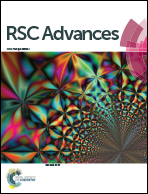Highly crystalline anatase TiO2 nanocuboids as an efficient photocatalyst for hydrogen generation†
Abstract
Highly crystalline anatase titanium dioxide (TiO2) nanocuboids were synthesized via a hydrothermal method using ethylenediamine tetraacetic acid as a capping agent. The structural study revealed the nanocrystalline nature of anatase TiO2 nanocuboids. Morphological study indicates the formation of cuboid shaped particles with thickness of ∼5 nm and size in the range of 10–40 nm. The UV-visible absorbance spectra of TiO2 nanocuboids showed a broad absorption with a tail in the visible-light region which is attributed to the incorporation of nitrogen atoms into the interstitial positions of the TiO2 lattice as well as the formation of carbonaceous and carbonate species on the surface of TiO2 nanocuboids. The specific surface areas of prepared TiO2 nanocuboids were found to be in the range of 85.7–122.9 m2 g−1. The formation mechanism of the TiO2 nanocuboids has also been investigated. Furthermore, the photocatalytic activities of the as-prepared TiO2 nanocuboids were evaluated for H2 generation via water splitting under UV-vis light irradiation and compared with the commercial anatase TiO2. TiO2 nanocuboids obtained at 200 °C after 48 h exhibited higher photocatalytic activity (3866.44 μmol h−1 g−1) than that of commercial anatase TiO2 (831.30 μmol h−1 g−1). The enhanced photoactivity of TiO2 nanocuboids may be due to the high specific surface area, good crystallinity, extended light absorption in the visible region and efficient charge separation.



 Please wait while we load your content...
Please wait while we load your content...